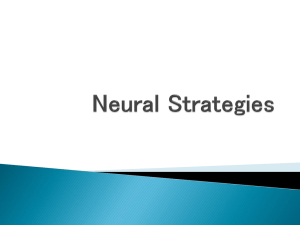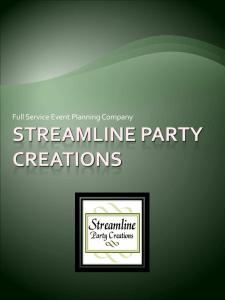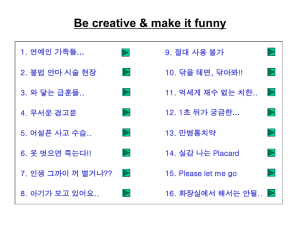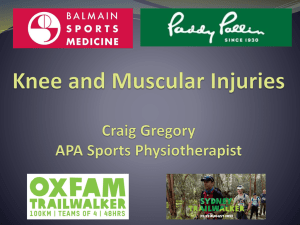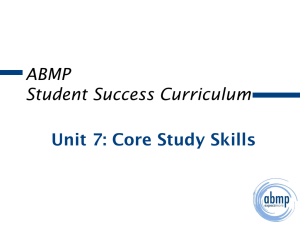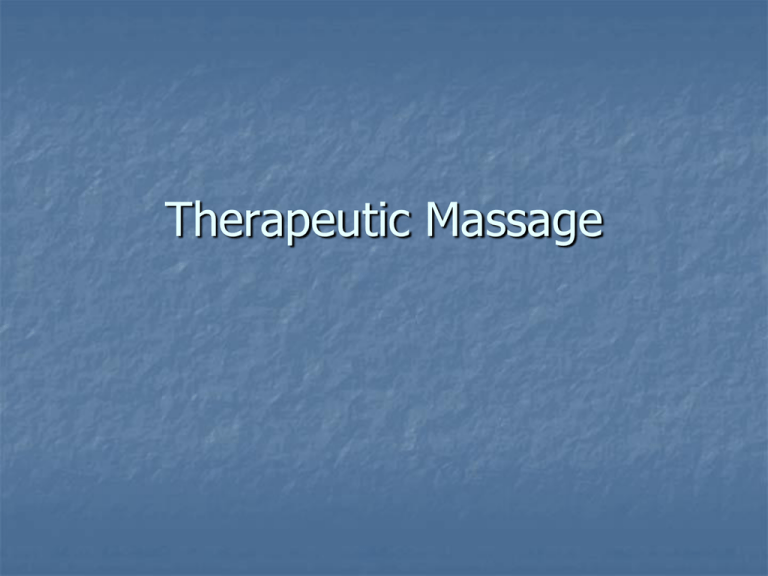
Therapeutic Massage
Massage
The act of rubbing, kneading, or stroking
the superficial parts of the body with the
hand or with an instrument.
Mechanical stimulation of the tissues by
means of rhythmically applied pressure
and stretching.
Massage
Reflexive Effects
Sedation is induced via slow, gentle, rhythmical
motion in order to relieve tension, soothe, and relax
musculature
Sensory receptors are
stimulated in the skin and
superficial fascia
Massage
Mechanical Effects
Mechanical or histological changes in myofascial
structures through direct superficial force:
Stretch muscle
Elongate Fascia
Mobilize soft tissue adhesions
Always accompanied by some reflexive effects
As mechanical effects become more effective,
reflexive effects become less effective
Mechanical techniques are best performed
after reflexive techniques
Massage
Psychologic Effects
General sedative effect
Decrease tension and anxiety
elicit feelings of well-being
“Hands on” effect helps patients feel as if
someone is helping them
Massage Benefits
Pain Control
Gate Control Theory
Cutaneous stimulation of large afferent nerve
fibers blocks transmission of pain carried in
competing small afferent nerve fibers
Release of endogenous opiates
Massage Benefits
Circulation
Light massage produces local dilation of
lymphatic and capillary vessels
Heavier pressure produces longer lasting
dilation
Blood flow increases, increasing the
temperature of the tissue being treated
Lymphatic flow increases, increasing the
removal of edema
Massage Benefits
Metabolism
Does not significantly alter general
metabolism
Increased blood flow does generate:
Increased dispersion of waste products
Fresh blood and oxygen supply
Removal of lactic acid
Massage Benefits
Musculature
Mechanical stretching
Relieve Pain
Increase ROM in hamstrings
Decrease neuromuscular excitability
Massage does not increase muscle
strength, bulk, or tone
Massage Benefits
Skin
Increased skin temperature
Loosens subcutaneous adhesions
Stretches and breaks down fibrous scar
tissue
Hoffa Massage
Classical massage techniques that use a
variety of superficial strokes that include:
Effleurage
Petrissage
Tapotement
Vibration
Effleurage
A stoke that glides over the skin without
attempting to move the deep muscle masses
Helps to accustom the patient to the contact of
the clinician
Initial strokes distribute lubricant
Search for areas of muscle spasm and soreness
with finger tips
Contact maintained at all times to enhance
relaxation
Every massage begins and ends with this stroke,
as well as in between other types of strokes
Effleurage
The stroke should
start at the
periphery and work
toward the heart
Effleurage
Pressure is applied
with the heel of the
hand, fingers slightly
bent, and thumbs
spread
Petrissage
Kneading manipulations that press and roll
the muscles under the fingers or hand
No gliding motions over the skin
Muscles are squeezed, lifted, and relaxed
Stroke moves from the distal to the
proximal point of muscular attachment
Grasp parallel to or at right angles to
muscular fibers
Petrissage
Petrissage
Smaller muscles may
be kneaded with one
hand
Petrissage
Larger muscles, or
muscular groups, will
require the use of
both hands
Tapotement
Percussion massage using a series of brisk
blows, administered with relaxed hands
and following each other in rapid,
alternating movements.
Hacking, cupping, slapping, beating,
tapping
Tapotement
Penetrating effect stimulates
subcutaneous structures
Increases circulation for more active flow
of blood
Peripheral nerve ending are stimulated
such that they convey impulses more
strongly
Tapotement
Hacking
Alternate striking of
patient with the ulnar
border of the hand
Tapotement
Slapping
Alternate slapping with
fingers
Tapotement
Beating
Half-closed fist using
the hypothenar
eminence of the hand
Tapotement
Tapping
Tips of the fingers
Tapotement
Clapping/Cupping
Use fingers, thumb,
and palm together to
form a concave
surface
Used primarily in
postural drainage
Massage Routine
Individual massage strokes alone do not
make a good massage
The form and progression of the massage
depend on the individual requirements of
the patient
Massage Routine
Example massage progression:
Superficial stroking (effleurage)
Deep stroking (effleurage)
Kneading (petrissage)
Tapotement
Superficial stroking (effleurage)
Friction Massage
According to the area to be covered, this
technique is performed by either the tips
of the fingers, the thumb, or the heel of
the hand
Make small circular movements that
penetrate into the depth of the muscle
Move the tissues under the skin rather
than moving the hands over the skin
Friction Massage
Friction Massage
Loosen adherent fibrous tissue
Reduce local muscular spasm
Provide deep pressure over trigger points
to produce reflex effects
Transverse Friction Massage
Treatment for chronic tendon
inflammations
Place the tendon to be treated on a light
stretch
Use the thumb or index finger to exert
intense pressure in a direction
perpendicular to the muscular fibers
Transverse Friction Massage
Massage performed every other day
7-10 minutes
Explain to the patient before beginning
the massage that it is a painful technique
It may be beneficial to apply ice to the
treatment area before beginning for
analgesic effects
Transverse Friction Massage
Myofascial Trigger Points
Hyperirritable locus within a taut band of
skeletal muscle, tendons, myofascia,
ligaments, joint capsules, periosteum, and
skin
Points may activate and become painful
due to direct muscle trauma or overuse
inflammation
Myofascial Trigger Points
This diagram shows an
example of a myofascial
trigger point and the
referred pain patterns for
one of the neck muscles.
This diagram shows an
example of a myofascial
trigger point and the
referred pain patterns for
one of the hip muscles
This diagram shows an
example of a myofascial
trigger point and the
referred pain patterns
for one of the neck
muscles
Myofascial Trigger Points
Pain from a particular point is usually
referred to areas that follow a specific
pattern
Stimulation of these points has been
shown to relieve pain
Referred pain is an important
characteristic of trigger points, and
differentiates them from tender points
Myofascial Trigger Points
Latent Trigger Points
Does not cause spontaneous pain
Can resist movement or cause muscular
weakness
Pain originates from the point when pressure
is applied directly over the point
Myofascial Trigger Points
Active Trigger Point
Causes pain at rest
Tender to palpation with a referred pain
pattern away from the trigger point
Pain described as spreading or radiating
Myofascial Trigger Points
Identification of Active Trigger Points
Palpation of a hypersensitive bundle or nodule
of muscular fiber of harder than normal
consistency
Palpation elicits pain directly over the affected
area and a radiating pattern of pain
Contraction against resistance increases pain
Firm pressure over the point elicits a “jump
sign”, crying out, wincing or withdrawing
Myofascial Release
Technique used to relieve soft tissue from
the abnormal grip of tight fascia
Once a myofascial restriction is located,
the massage should be directly through
the restriction
Progress from superficial tissue to deep
tissue
Treatment recommended 3 times per
week
Indications for Massage
Muscular, tendon,
and joint
conditions
Adhesions
Muscle spasms
Myositis
Tenosynovitis
Postural strain of
back
Bursitis
Fibrositis
Tendinitis
Contraindications for Massage
Arteriosclerosis
Thrombosis
Embolism
Severe varicose veins
Acute phlebitis
Celluitis
Synovitis
Abscesses
Skin injections
Cancers
Pregnancy
Acute inflammatory
conditions of skin,
joints, and soft tissue


